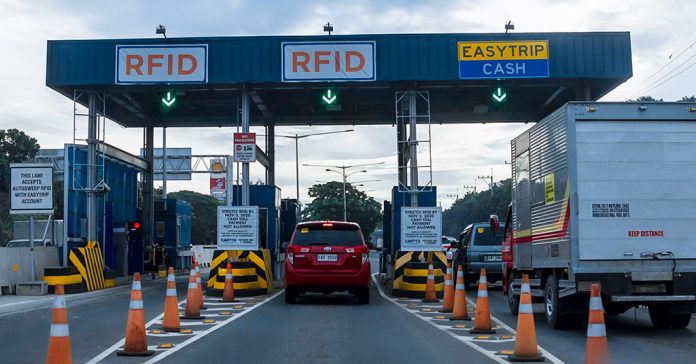
Road trips are a great way to travel the country. When you’re hitting the road in some way in the Philippines, you’re probably going to encounter expressways at some point or another.
As we all know, the rules for the use of expressways, specifically the toll fees, change often, and it can be hard to keep track. It’s especially hard to remember the rules or the fees of these expressways when you don’t use them quite often.
With that said, if you’re interested in going on a road trip soon and you feel like you’re going to stop by a lot of these expressways, then you want to know more about the fees associated with them and other rules around them to avoid any hassle while on the road.
To begin our understanding of the major expressway toll fees in the Philippines, let’s first start with defining what exactly an expressway is.
What Are Expressways?
An expressway is a type of highway that has a controlled place for exiting and entering either partially or fully where fast traffic is designed to drive. The expressway is usually divided into different lanes based on cars that are driving in opposite directions.
There are a lot of expressways in the northern and southern Luzon areas, which makes sense because it is the island region that has the largest land area. However, there are also plenty of expressways in other parts of the country as well.
Some people who are interested in expressways often ask why we need to pay to use these roads. We’ll cover that question next.
Why Do We Pay Toll Fees in the Philippines?
If you ever travel abroad and encounter an expressway there, you might notice at some point that there are no toll fees to pay for some of these countries while others do have toll fees. So, in the case of the Philippines, you might be wondering why we pay toll fees here for the use of expressways.
The reason why some expressways or most of them in the Philippines come with a toll fee is that it is privately managed and funded, which means that there are fewer tax obligations on the average Philippine resident.
Since it’s privately managed and funded, the corporation that owns the expressway tolls under concession with the Department of Public Works and Highways (DPWH) charges for the use and maintenance of the expressway.
If it was the government that managed and funded the creation of the expressway, then it would probably be free, but it will be included in the computation of our income taxes.
Different Major Expressways in the Philippines
When you’re traveling to the Philippines, you will encounter quite a few expressways. Here are some of the major expressways that people most often drive through that you should know.
North Luzon Expressway (NLEX)
The North Luzon Expressway or NLEX is a highway in the Philippines that connects Metro Manila to the provinces of Bulacan, Pampanga, and Tarlac to name a few.
The NLEX is one of the busiest highways in the Philippines. It’s an important thoroughfare with a length of 101.8 kilometers. The expressway has several exits that connect to other highways, including Skyway Stage 3 and the South Luzon Expressway.
NLEX has been criticized for its high toll rates due to its limited lane capacity as well as its lack of traffic management systems. Since the NLEX connects other parts of cities in Metro Manila to one another as well, it can get congested quite a bit during rush hour. Therefore, if you’re planning on going through here, you might want to avoid rush hour so you don’t get stuck in traffic.
South Luzon Expressway (SLEX)
The South Luzon Expressway, also known as the SLEX, is a toll road in the Philippines that is about 46.9 kilometers long. The SLEX is an important road that connects Metro Manila to other provinces in Southern Luzon.
Back in the day, it had the name South Superhighway. Its main use is that it connects Metro Manila to the CALABARZON region.
Metro Manila Skyway System (MMSS)
The Metro Manila Skyway System or MMSS is a network of elevated highways in Metro Manila.
The main capability of MMSS is that it connects the NLEX and SLEX to the Ninoy Aquino International Airport or NAIA through the NAIA Expressway. The system is still ongoing construction so not all of the entrances and exits are there for public use.
The creation of the MMSS is also there to help ease traffic congestion in various parts of Metro Manila.
Apolinario Mabini Superhighway
The Apolinario Mabini Superhighway used to have the name the Southern Tagalog Arterial Road or the STAR Tollway or even the CALABARZON Expressway. This expressway is a two to four-lane highway with a length of 41.9 kilometers.
You can use this expressway to reach the Batangas International Port as well as Malvar, Lipa, Ibaan, and more. The plan for this expressway is to extend it to various barangays in Batangas to also ease traffic congestion there.
Manila Cavite Expressway (Cavitex)
The Manila Cavite Expressway connects Metro Manila directly to the province, hence the name. It is around 14 kilometers long. Back in the 1970s, the area where the Cavitex stands was an untolled road, but due to the volume of traffic, it needed more upkeep.
Now, it’s a joint venture between the Public Estates Authority Tollway Corporation (PEATC) and the Cavite Infrastructure Corporation.
Subic-Clark-Tarlac Expressway (SCTEX)
The Subic-Clark-Tarlac Expressway or SCTEX is a fairly recent expressway that was built in 2008. As of now, the SCTEX is the country’s longest expressway with a length spanning around 93.77 kilometers.
The SCTEX helped make it easier and faster to travel from Clark to Subic and Clark to Tarlac.
Ninoy Aquino International Airport Expressway (NAIAX)
The NAIAX is the country’s first airport expressway that connects the Manila Skyway to NAIA as well as Diokno Avenue and CAVITEX. It is about 11.6 kilometers long. Due to the limited space of the NAIAX, the max speed limit in it is around 60 kilometers per hour, unlike the other expressways which can have a higher speed limit.
Subic Freeport Expressway (SFEX)
The Subic Freeport Expressway or SFEX used to be called the Subic Tipo Expressway and is around 8.8 kilometers long. The main goal of the SFEX is to connect the SCTEX with the Subic Freeport Zone as it extends along Bataan to Zambales.
Muntinlupa-Cavite Expressway (MCX)
The Muntinlupa-Cavite Expressway or MCX connects Muntinlupa City to Cavite and is one of the shortest expressways in the country with a length of around four kilometers. It also connects specifically Daang Hari and SLEX. Right now, it’s under the ownership of DPWH and is under the operations of the MCX Tollway Inc.
Tarlac-Pangasinan- La Union Expressway (TPLEX)
The Tarlac-Pangasinan-La Union Expressway or TPLEX connects the Ilocos region to the Central Luzon region. The expressway is around 89.21 kilometers long which makes it one of the longest expressways in the country as well alongside the SCTEX.
Cavite-Laguna Expressway (CALAX)
The Cavite-Laguna Expressway or CALAX connects the province of Laguna and Cavite together and is a partially operational expressway with a length of 44.63 kilometers. It aims to connect the Cavitex to the SLEX to help ease the traffic within both the provinces of Cavite and Laguna.
Different Classifications of Tollway Vehicles
Now that you know a lot of the major expressways in the country, you might want to start figuring out the toll fees for each. However, the price of some of these expressway tollways would usually depend on the kind of vehicle you bring with you or are using.
With that in mind, here are the different types or classifications of tollway vehicles and how that affects your toll fee.
- Class 1 Vehicles: Vehicles with a max of two axles and an overall height of 2,286 millimeters (mm) or 7.5 feet.
- Class 2 Vehicles: Vehicles with a max of two axles and an overall height exceeding 2,286 mm or 7.5 ft.
- Class 3 Vehicles: Trucks with three or more axles and a height greater than 2,286 mm or 7.5 ft.
Do note that if you add bike racks or other accessories on top of your private vehicle that could make it exceed the 7.5 feet limit, then your vehicle can count as a different class. Therefore, make sure that you take note of that when passing through the expressway.
Also, the price of your toll fee will increase the higher up the class you go to, so Class 3 vehicles would usually have to pay a lot more. That’s because these vehicles are heavier and cause more damage to the expressway because of their weight.
How Much Are Expressway Toll Fees in the Philippines?
Now it’s time to get to the real meat of it all and cover the different toll fees for the different expressways in the country.
NLEX-SCTEX Toll Fees Matrix
If you’re wondering how much is the toll fee in NLEX or SCTEX, the Toll Regulatory Board (TRB) if the Philippines has the answer.
Cavitex Toll Fees Matrix
If you’re wondering how much are the toll fees in CAVITEX, then here is TRB’s toll fee matrix. These rates are based on their rates as of May 12, 2022.
| SEGMENT | Tollable Length (in km) | Class 1 | Class 2 | Class 3 |
| R-1 Expressway | 6.475 | 33.00 | 67.00 | 100.00 |
| Kabihasnan | 2.85 | 8.00 | ||
| R-1 Expressway Extension | 7.00 | 64.00 | 129.00 | 194.00 |
| C5 South link (Seg. 3A-1) | 2.2 | 22.00 | 44.00 | 66.00 |
TPLEX Toll Fees Matrix
For those who are planning on passing through the TPLEX, here are the toll fees that you can expect to pay.
Class 3 Vehicles
| ENTRY/EXIT | La Paz | Victoria | Gerona | Paniqui | Moncada | Carmen | Urdaneta | Binalonan | Pozorrubio | Sison |
| La Paz | ||||||||||
| Victoria | 91.00 | |||||||||
| Gerona | 175.00 | 84.00 | ||||||||
| Paniqui | 237.00 | 146.00 | 62.00 | |||||||
| Moncada | 396.00 | 206.00 | 122.00 | 60.00 | ||||||
| Carmen | 492.00 | 401.00 | 317.00 | 255.00 | 195.00 | |||||
| Urdaneta | 648.00 | 557.00 | 473.00 | 411.00 | 351.00 | 156.00 | ||||
| Binalonan | 704.00 | 614.00 | 530.00 | 468.00 | 408.00 | 213.00 | 57.00 | |||
| Pozorrubio | 810.00 | 719.00 | 635.00 | 573.00 | 514.00 | 318.00 | 162.00 | 106.00 | ||
| Sison | 871.00 | 781.00 | 697.00 | 635.00 | 575.00 | 380.00 | 224.00 | 167.00 | 62.00 | |
| Rosario | 933.00 | 843.00 | 759.00 | 697.00 | 637.00 | 442.00 | 286.00 | 229.00 | 124.00 | 62.00 |
CALAX Toll Fees Matrix
The toll fee for driving along the CALAX would cost around the following:
Class 1 Vehicles
| Toll Plazas | Silang East | Santa Rosa – Tagaytay | Laguna Boulevard |
| Santa Rosa-Tagaytay | 27.00 | ||
| Laguna Boulevard | 33.00 | 14.00 | |
| Technopark | 48.00 | 29.00 | 15.00 |
| Greenfield | 64.00 | 44.00 | 30.00 |
Class 2 Vehicles
| Toll Plazas | Silang East | Santa Rosa – Tagaytay | Laguna Boulevard |
| Santa Rosa-Tagaytay | 55.00 | ||
| Laguna Boulevard | 67.00 | 29.00 | |
| Technopark | 97.00 | 59.00 | 30.00 |
| Greenfield | 128.00 | 89.00 | 60.00 |
Class 3 Vehicles
| Toll Plazas | Silang East | Santa Rosa – Tagaytay | Laguna Boulevard |
| Santa Rosa-Tagaytay | 83.00 | ||
| Laguna Boulevard | 100.00 | 43.00 | |
| Technopark | 146.00 | 89.00 | 45.00 |
| Greenfield | 192.00 | 134.00 | 91.00 |
Metro Manila Skyway Stage 3 Toll Fees Matrix
For the Metro Manila Skyway Stage 3, here is how much the toll fees would cost.
Class 1 Vehicles
NORTHBOUND
| ENTRY/EXIT | Quirino | Plaza Azul/Nagtahan | Quezon Avenue | A.Bonifacio-Balintawak | NLEX |
| Buendia | 105 | 105 | 264 | 264 | 264 |
| Plaza Azul/Nagtahan | 264 | 264 | 264 | ||
| E. Rodriguez | 129 | 129 | 129 | ||
| Quezon Avenue | – | – | 129 | 129 |
SOUTHBOUND
| ENTRY/EXIT | Quezon Ave. | E.Rodriguez | Plaza Azul/Nagtahan | Buendia |
| NLEX | 129 | 129 | 264 | 264 |
| Balintawak-A.Bonifacio | 129 | 129 | 264 | 264 |
| Quezon Avenue | – | 129 | 264 | 264 |
| Plaza Dilao | – | – | – | 105 |
Class 2 Vehicles
NORTHBOUND
| ENTRY/EXIT | Quirino | Plaza Azul/Nagtahan | Quezon Avenue | A.Bonifacio-Balintawak | NLEX |
| Buendia | 210 | 210 | 528 | 528 | 528 |
| Plaza Azul/Nagtahan | – | – | 528 | 528 | 528 |
| E. Rodriguez | – | – | 258 | 258 | 258 |
| Quezon Avenue | – | – | – | 258 | 258 |
SOUTHBOUND
| ENTRY/EXIT | Quezon Ave. | E.Rodriguez | Plaza Azul/Nagtahan | Buendia |
| NLEX | 258 | 258 | 528 | 528 |
| Balintawak-A.Bonifacio | – | 258 | 528 | 528 |
| Quezon Avenue | – | 258 | 528 | 528 |
| Plaza Dilao | – | – | – | 210 |
Class 3 Vehicles
NORTHBOUND
| ENTRY/EXIT | Quirino | Plaza Azul/Nagtahan | Quezon Avenue | A.Bonifacio-Balintawak | NLEX |
| Buendia | 315 | 315 | 792 | 792 | 792 |
| Plaza Azul/Nagtahan | – | – | 792 | 792 | 792 |
| E. Rodriguez | – | – | 387 | 387 | 387 |
| Quezon Avenue | – | – | – | 387 | 387 |
SOUTHBOUND
| ENTRY/EXIT | Quezon Ave. | E.Rodriguez | Plaza Azul/Nagtahan | Buendia |
| NLEX | 387 | 387 | 792 | 792 |
| Balintawak-A.Bonifacio | – | 387 | 792 | 792 |
| Quezon Avenue | – | 387 | 792 | 792 |
| Plaza Dilao | – | – | – | 315 |
Paying Your Expressway Toll Fees
Now that you know how much the toll fees for some of the major expressways in the country cost, it’s time to figure out how you’re going to pay for them. One of the most popular ways to pay it and one that the powers that be recommend for you to use would be using the RFID that is common nowadays.
Can you still pay in cash on expressways?
If you don’t have an RFID or somehow haven’t gotten one yet, then you can always pay in cash. There are some dedicated tollways that accept cash payments. You can go through those instead of the ones marked with RFID to pay with cash.
FAQs on using the RFID
Another alternative way of paying the expressway toll fee in the Philippines is by using the RFID. So, let’s cover some of the most frequently asked questions about using the RFID.
What is an RFID?
RFID is short for radio frequency identification which uses frequencies to tag and identify something. It is now used in many expressways in the country so that you can pay the toll fee based on how much load you have without having to interact with someone.
It became particularly popular or needed during the height of the pandemic, which is why many expressways have lanes or tollways dedicated to RFID users.
Different expressways use different RFIDs, but the two main ones would be the EasyTrip and Autosweep RFID. You will need to install different ones on your vehicle depending on the expressway you’re going to use.
Where do you get an RFID?
There are multiple different RFID installation sites connected to some of the expressways in the country. Here are some of the RFID installation sites that you can go to.
Auto sweep Installation Sites:
- Skyway and NAIAX
-
-
- Bicutan Drive Thru
- C5 Toll Northbound
- C5 Customer Service Center (CSC) Southbound
- NAIAX Main Toll Plaza A and B
- Nichols Toll Plaza
- Old NAIAX Drive Thru, Westbound
- Petron C5
- Petron Commerce Avenue
- Petron Dasmarinas
- Petron NAIAX
- Petron Valle Verde
- Runway Toll Plaza
- Shell Magallanes
- Sucat Southbound After the Exit
-
- SLEX and MCX
-
-
- After the Calamba Entry Toll Gate
- Ayala Greenfield CSC
- Cabuyao Toll Plaza Southbound
- Eton Toll Plaza Northbound
- Filinvest Toll Plaza
- Mamplaza Toll Plaza Northbound and Southbound
- MaTES Office Silangan Northbound
- Petron Evia
- Petron San Pedro
- Shell Mamplasan
- Shell Putatan
- Southwoods CSC Northbound and Southbound
- Southwoods Toll Plaza Northbound
- Sta. Rosa CSC Northbound
- Sta. Rosa CSC Southbound
- Susana Heights Toll Plaza Southbound
-
- Apolinaro Mabini Superhighway (STAR Tollway)
-
-
- Batangas Drive Thru Southbound
- Lipa Tollgate Southbound
- Petron Lipa
- Petron Malvar
- Star Toll Lipa CSC in Tambo Exit
- Sto. Tomas Drive Thru Northbound
-
- TPLEX
-
- Carmen Toll Plaza
- Petron Pura Northbound and Southbound
- Pura Toll Plaza
- Rosario Toll Plaza
- Tarlac Toll Plaza
- TPLEX Tarlac Main Office Northbound
- Urdaneta Toll Plaza
- Victoria Toll Plaza
EasyTrip Installation Sites:
- NLEX and SCTEX
-
-
- Angeles SB EasyTrip Tent
- Balintawak AOVP EasyTrip Tent
- Balintawak EasyTrip Tent at the CSC Parking Area
- Mindanao NB EasyTrip Tent
- NLEX Drive and Dine
- Petron Balagtas SB
- Petron Lakeshore
- Petron Marilao NB
- San Fernando CSC Parking Area
- Seaoil SCTEX
- Shell Balagtas NB
- Tabang CSC EasyTrip Tent
- Total SB SFEX
- Valenzuela Southbound EasyTrip Tent
-
- C5
-
-
- C5 Customer Service – West Service Road
- C5 Extension Road Junction, Taguig City
- Merville Toll after the toll plaza
- Shell Magallanes
- Taguig Toll
-
- Cavitex
-
-
- Kabihasnan Toll – Manila-bound
- Kawit Northbound EasyTrip Tent – Manila-bound Kawit Toll Plaza
- Longos Bacoor Northbound – Manila-bound Longos Entry
- Paranaque CSC
- Shell Panapaan
- Shell Real II
- Shell Talon Uno
-
- CALAX
-
- Ayala Malls Solenad
- Laguna Boulevard A and B
- Laguna Technopark
- Mamplasan-Greenfield CSC
- Mamplasan-Rotonda
- Sta. Rosa EasyTrip Tent – Exit Arch
You can also get a load for your RFIDs there.
Where should I install the RFID on the vehicle?
You can’t install the RFID if you have a tint on your car. The ideal place to install it would be behind your rear-view mirror because the scanner can easily detect it and it won’t obstruct anything in terms of your view while driving.
Where can I load up my RFID?
There are many places and ways for you to load up your RFID. You can use GCash, for example, and other E-wallets and even online banking partners. Other places where you can load your RFID are through:
- Malls
- Convenience stores
- Gas stations
- Supermarkets
- E-wallets
- Online banking
- Payment centers
How do I check the balance of my RFID?
If you want to know how much you still have in your balance, then you can do so in three ways: through the mobile app of your RFID, through their website, or by texting.
What happens when I have insufficient funds in my RFID?
If you go through a toll gate with insufficient funds in your RFID, then the barrier might not activate and you won’t be able to go through. Worst case scenario is that you will get a fine of PHP 1,000 for causing an obstruction based on the three-strike policy.
Can I transfer my RFID to a different car?
No, you can’t transfer your RFID to a different car because it already is identifying a specific type of vehicle for you. Therefore, you will have to get a different RFID if you have multiple vehicles.
Conclusion
To avoid any confusion, setbacks, and hassle, it’s best to know more about the toll fees you’re going to encounter, especially when going on a long road trip in the country. Hopefully, the details in this article will help you prepare accordingly.
Next time you’re about to head out for a long road trip, check out this article to help guide you on the toll rates of different expressways in the country.




